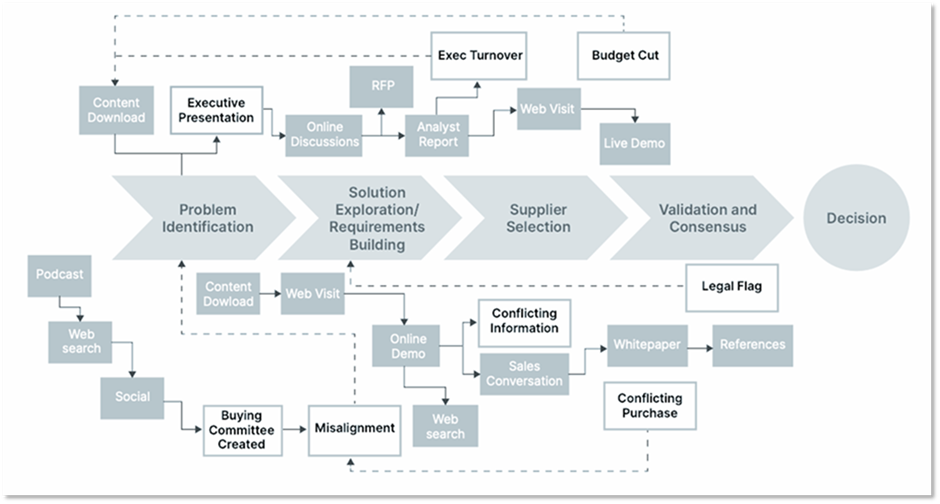Business leaders often talk about sales and marketing alignment in terms of some sort of epic Lord of the Rings quest. It’s no crusade, but it is a journey demanding specific tools, characteristics and climate to achieve success.
I’ll be straight - it’s not an easy process; it takes time and proper planning, but when done right will benefit the business in the long run - in a big way. It’s important to note that as much as possible, leadership should have the buy-in of team members so they’re greatly invested in the process and outcomes. (If you don’t have team buy-in, now might be the time to ask yourself, “ Do I have the right team..?”)
The "why" of marketing and sales alignment
Everyone should be excited about this journey. Why?
- 50% of sales time is wasted on unproductive prospecting - but sales reps ignore 50% of marketing leads. Mainly because they don’t think they’re good enough (The B2B Lead and TAS Group).
- Failure to align sales and marketing teams leads to wasted budget and resources as up to 60-70% of B2B content is not being used, and close to 75% of marketing leads never convert into a sale.
- Working together, these teams can generate 32% higher revenue, retain 36% more customers and achieve 38% higher win rates.
No one can afford wasted time, effort and resources on their teams. Not ever, but particularly in today’s economic and professional environments. Everyone wants and needs more wins. What does that look like, specifically?
What does success look like?
- Team efficiency and performance: Aligned teams are 67% more efficient at closing deals. They also save 30% on their customer acquisition cost - and those have a 20% higher lifetime value (MarTech Alliance).
- Improved customer experience: Development of a more seamless customer experience. Sales teams can better understand their clients and offer more personalised solutions by utilising marketing's insightful consumer wants and preferences data.
- Revenue growth: Collaboration leads to developing a more effective sales funnel. Businesses with this alignment can generate more than 200% revenue growth from marketing tactics and experience 24% faster growth in revenue (MarTech Alliance).
- Messaging consistency: They develop constant messaging that appeals to customers at all stages of the buying journey. This drives credibility and trust amongst customers, leading to loyalty, which drives sales and retention.
- Improved data analysis: Collaboration leads to the effective gathering and analysis of customer data as insights are drawn from a place of common goals, and information is shared freely.
Sounds great, right?
Where to start
Culture
There is often friction between sales and marketing; this is the first thing that’s gotta go. Overall, 87% of the terms both use to describe each other are negative (CEB). This isn’t a great foundation for any relationship.
This friction can be bred from sales finding it difficult to see how marketing contributes to the bigger picture. There’s often the misperception that the former sells and the latter builds audience/visibility. True at its most basic.
However, this view misses a crucial point: both teams’ ultimate goal is to drive revenue. Strategies and speed may differ, but the objective is the same.
If team goals and value is misunderstood by both parties, it can breed a culture of at best, frustration, at worst distrust - or even disdain. How do you fix this?
Start with something simple: Hang out together! Psychology dictates that people who know and like each other find ways to work through challenges and help one another. Team building, happy hour, industry events, whatever it is, get them together to have some fun.
Next, educate. Both teams should understand the latest in customer journey (complicated, see below), meaning that a simple relay handover is no longer effective in winning. Sales and marketing must work more like a football team, passing the ball back and forth down the field. They should also understand your business’s particular customer journey - if that hasn’t been mapped yet, it needs to be.
We also recommend marketing attend more customer and prospect calls, so they can better understand the wants and needs of their targets.

Part of this education includes visibility of processes: As mentioned, it’s sometimes difficult for the rest of the business to see how marketing content contributes to revenue, particularly as these strategies often take time. You should embark on a deep dive of processes, where sales and marketing get an inside view of what the other team is doing (e.g. what’s next quarter’s strategy?), how they track success, where to find the information they each might need, how each other’s dashboards work and look like, etc.
Better yet, undertake a major process together, like developing a lead nurturing strategy or sales enablement. A lead nurturing strategy involves deciding how you will cultivate leads depending on their persona and what stage of the buying process they’re in. Which department will contact them and when? And how?
Sales enablement is a process of aligning your sales team with the product value by providing them with information, resources and tools they need to successfully prospect and convert customers throughout your sales process/funnel. Those tools are created by marketing and product marketing and informed by sales and customer success, bringing the teams together in a learning and educational environment with clear ROI. This also creates consistent messaging and the related benefits mentioned above.
This means a heck of a lot more communication: There should be regular meetings to communicate customer feedback, what’s working, what isn’t and finding solutions cross-functionally. Not to mention identifying and setting shared goals, OKRs, KPIs and metrics.
Shared KPIs can include:
- Cost per lead
- MQLs and SQLs
- Customer retention
- Cost per customer acquisition
- Marketing ROI
- Sales revenue
Alignment of strategies and priorities: Strategies should not be built in silos; team leaders should build their strategies cohesively to reinforce the football play analogy. Egos have no place here - we all know what can happen when a star player tries to take a goal on their own without the necessary help from their team.
Moreover, ensure these strategies are shared. You wouldn’t believe how often employees aren’t in on the big picture - the why behind their KPIs.
The most significant tactical pain point to solve is a joint definition of a lead. The greatest source of conflict between the two teams tends to be marketing sending through what they feel are qualified leads, with sales never following through because they don’t find them to be qualified - leading to dissatisfaction on both sides.
To fix this, you definitely need to:
- Create your Ideal Customer Profile (ICP). Your ICP defines the firmographic, environmental and behavioural attributes of accounts that are expected to become a company's most valuable customers.
- Get your personas in place. A buyer persona is a semi-fictional representation of your ideal customer based on market research and real data about your existing customers. It brings together consumer demographics, behaviour patterns, motivations and goals and is a tremendous source of intelligence for your business.
Whilst led by marketing, these exercises rely on sales input (and customer success). Both are vital for embedding focus within your teams and allow another opportunity to build trust, communication and cross-functional working relationships.
Then marketing and sales must work together to build acceptable criteria for MQLs and SQLs.
By undertaking these exercises, you build a culture of teamwork, process, transparency and connection.
Upskilling
In the process of building this super-team, it may become apparent that the individuals on your team need to gain more knowledge or skill sets. Recruitment isn’t always an option to fill the gaps, nor should it always be your first choice. This is an opportunity to strengthen your team and add value to the business.
Identify your skills gap.
- What are the individuals on your team great at?
- Where could they use support?
- What skills are you lacking completely that would make an impact?
- How does the addition of these help the business achieve their goals?
Build a spreadsheet so that you always have this information at your fingertips.
Talk to your team and your leadership about the gaps you’ve established, how you want to fill them, and why.
Offer opportunities for professional development. And by that I don’t mean in their free time on their own dime (don’t be cheap). MIT Management outlines that businesses that invest in the right experience for their employees and look to future-proof their workforce tend to outperform their competitors. They deliver on average 19% more revenue growth and 15% more profit.
“These companies are also more innovative, better at cross-selling and deliver a significantly better customer experience,” said Kristine Dery, Research Scientist at MIT Center for Information Systems Research.
Beyond this, the reality is that the customer and technology landscape is constantly shifting in today’s world. For marketers, they must understand the latest algorithm updates and technologies that can get your product/service in front of the right audience at the right time. For sales, consumer habits shift, best practices evolve. If both teams don’t stay on top of this intel, they will not be in lock step with the modern buyer journey and your bottom line will be affected as a result.
It is in your company’s best interest to continuously invest and develop its people. Research shows it also boosts retention, reputation, valuation, morale and productivity, amongst other benefits.
Ensure there is a budget set aside for development. Encourage your employees to come to you with suggestions of where they’d like to improve and how that can be achieved. Cross-check this with your skills gap analysis.
Technology
Tech is the crucial linchpin to the success of your sales and marketing alignment. The most impactful piece of technology here is your CRM. Note: one CRM. One source of truth.
Another major source of friction between sales and marketing - and your customers - is disparate sources of information about your customers and prospects.
Having more than one CRM creates a host of issues, including a few I’ve dealt with personally:
- Not enough platform licences so lack of transparency and access to needed reports and customer information
- CRMs that don’t speak to each other consistently, resulting in broken or incomplete data
- One person who’s entire job is to fix the CRMs talking to one another - aren’t they always out of office at a crucial moment?
- Customer complaints because not all of their information is where necessary teams can see and act on it.
The list goes on.
As a HubSpot agency, we obviously recommend HubSpot, particularly for SMEs. It’s affordable, easy to use and the customer service is bar none. The ease of use is always high on the tick box, especially if you have a sales team reluctant to input data or utilise their existing platform to its full potential. Its sales enablement and reporting tools are also arguably the best on the market.
As amazing as your CRM is (whatever option you choose), there are still things it just doesn’t do and you’ll need to supplement to give both your marketing and sales team greater insights. Business analytics.
These include website insights from the likes of HotJar - what are people doing - or not doing - on your website?
A Leadfeeder - they identify those anonymous people on your website and translate them into leads.
Your CRM will likely have a chatbot tool, but it won’t be as sophisticated as something like Drift, which can connect a potential customer to your sales team in seconds or push the relevant marketing content in real-time.
A piece of tech like ZoomInfo enriches your data and ensures it’s always up to date.
If you’re implementing any sort of ABM strategy (talk about supercharging your marketing and sales alignment!) then you may also be considering a programmatic platform like RollWorks, 6sense or Demandbase. These allow your marketing team to run personalised ads and content at specific members of your target company’s buying committee, at certain times when you know them to be most active or at the right stage of your funnel - and then notify your sales team when they’re a hot, qualified prospect.
Whatever add-ons you choose, understand if and how they integrate into your CRM. CRM integrations are the seamless connectivity between your CRM software and third-party applications. Going back to your one source of truth, do your research and choose the platforms that work best with your CRM. Don’t choose any tech that needs the likes of Zapier or other connections if possible.
All of this also acts as a solid foundation to consider building a RevOps (Revenue Operations) function within the business, which is the ultimate in cross-functional alignment.
RevOps
RevOps is the strategic integration of B2B sales, marketing and service departments (think customer service, customer success, finance) that uses automation to help teams make decisions that grow the business. RevOps facilitates collaboration between teams that have a direct impact on a company’s revenue.
RevOps is on the rise exactly for the reasons outlined earlier in this article. The buyer journey is changing (According to SiriusDecisions, B2B buyers are typically 57% of the way to a buying decision before actively engaging with sales) and customers expect highly personalised journeys based on previous interactions.
Information on existing and potential customers is coming from so many sources, it increasingly makes sense to have one team responsible for sifting intel, presenting relevant data and overseeing actionable change. Ultimately, a 360-degree view of the customer pre-, during and post-sale is more vital than ever.
As such, some of the key metrics RevOps is responsible for include:
- Annual Recurring Revenue (ARR)
- Customer Lifetime Value (CLV)
- Customer turnover rate
- Sales cycle time
- Win rate
Though RevOps is still fairly new, HubSpot reports that, “preliminary research shows it can be a promising approach for companies looking to break through a plateau”. Gartner predicts that 75% of the highest growth companies in the world will deploy a revenue operations model by 2025.
“CEOs and chief sales officers recognise that functional silos handing off clients from one function to the other, and using different technologies, people and processes, are a barrier to revenue growth,” said Doug Bushée, Senior Director Analyst. “As a result, progressive organisations are beginning to align sales, marketing and customer success technology, data and KPIs to provide an end-to-end view of the revenue-generating engine.”
It’s never too late to be a “progressive organisation”. More to the point, sales and marketing alignment (and maybe some other departments too) result in higher growth - along with some other pretty big wins.
Don’t be scared by the substantial list of things outlined here - it’s a journey, remember? And we’re here to help if you need it.




